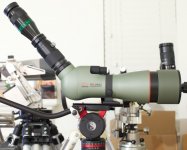Hello,
I just posted basically the exact same reply in another thread, but why not double it up

I just purchased a Kowa 883 and have some answers to questions here, as well as some questions of my own. I figured it was better to revive an old thread rather than start a new one. Hold on to your butts...
I have the Kowa 883 with TE-11WZ eyepiece, as well as the Kowa 1.6x adapter (adapter highly recommended). I also have an astro eyepiece: the TeleVue Nagler 3-6mm zoom. As for the astro adapters, I have the Kowa adapter with thumb screws, and the Baader with grub screws and brass compression ring.
Here are my observations so far which will hopefully help some of you:
- Acknowledged that 176x is the recommended maximum for this scope, but I have taken it to 276x (Nagler zoom @ 3mm with 1.6x) both terrestrially and looking at the moon. The moon is so big, and so bright that I don't know what the maximum zoom is while looking through this scope, but the max is certainly beyond 276x; atmospheric conditions will be your limiting factor. I find the moon easiest to spot without any eyepiece installed at all, just stand back and rough it...youll see the open cavity in the back of the scope get bright when you're close, it takes seconds. I've also taken the scope to 276x terrestrially and it's equally as impressive. Again, limited by atmospheric conditions. I had it outside in about -15C mid day while testing this and could, albeit with some difficulty, correctly discern words on a pedestrian sign about 700 meters away. I'll confirm the distance if anyone is interested.
- the Nagler 3-6mm Zoom is an awesome companion to the TE-11WZ; between the two of them they cover a pretty impressive range, especially when the 1.6x extender is in the mix. The Nagler is not without its faults however...it's only functional with the extender (unless someone here has a solution), which I'll explain.
- The Nagler zoom has a longer barrel than other 1.25" eyepieces which will cause it to bottom out before the eyepiece 'astro adapter' hits the 'shoulder' of the eyepiece. What does this mean... It turns your Kowa into a microscope instead of a telescope. Continue below:
- Scenario 1: Nagler 3-6mm Zoom WITHOUT 1.6x Kowa extender. Focus range is from 13ft to about 150ft. I performed a series of tests to figure out wtf the problem is, and the result is this...the eyepiece will not seat far enough into the scope's receiver to achieve infinity focus.
- Scenario 2: Nagler 3-6mm Zoom WITH 1.6x Kowa extender. Focus range minimum was not tested, however it was able to achieve focus on the moon (I'm not sure if this constitutes infinity focus). As previously mentioned, I could also read the really far away sign (read above). Why the difference you ask?? The 1.6x extender allows the astro eyepieces to be seated 1-2mm deeper into the socket so-to-speak. I roughly measured this by scribbling pencil onto the barrel of the eyepiece. Again, I can take more exact measurements with calipers if anyone is interested.
- With a fixed focal length eyepiece I don't think you'll have the issues I've experienced as they have a 'normal' length barrel; any 1.25" astro eyepiece SHOULD work with or without the extender...but then again that's what I thought.
- I can't offer any advice over which astro adapter to buy (the Nagler zoom bottoms out so this is irrelevant for me). However, don't forget the issue I've experienced...I can't achieve infinity focus because the eyepiece will not seat deep enough; the thumb screw variant of the astro adapter may present this problem in exchange for it's convenience. To clarify, the thumb screw variant of the astro eyepiece adapter may not allow the eyepiece to seat to it's fullest potential. If in doubt, buy both. You've already spent thousands of dollars, what's another $30.
Here's my question:
How do I "trick" my Nagler zoom think it's closer to the scope than it actually is? Is there an optical device or filter I can place between the eyepiece and the scope itself, keeping in mind it's already bottomed out? The best solution I can think of so far is a focal reducer, but I'm too much of a noob to know if it'd actually work (albeit robbing me of zoom). A much lousier option would be to machine off the bottom off the eyepiece allowing it to sit that 2mm closer...of course the trade off is that you'll no longer be able to attach filters as you're essentially removing the threads that would accept them and voiding any warranty on the process.








